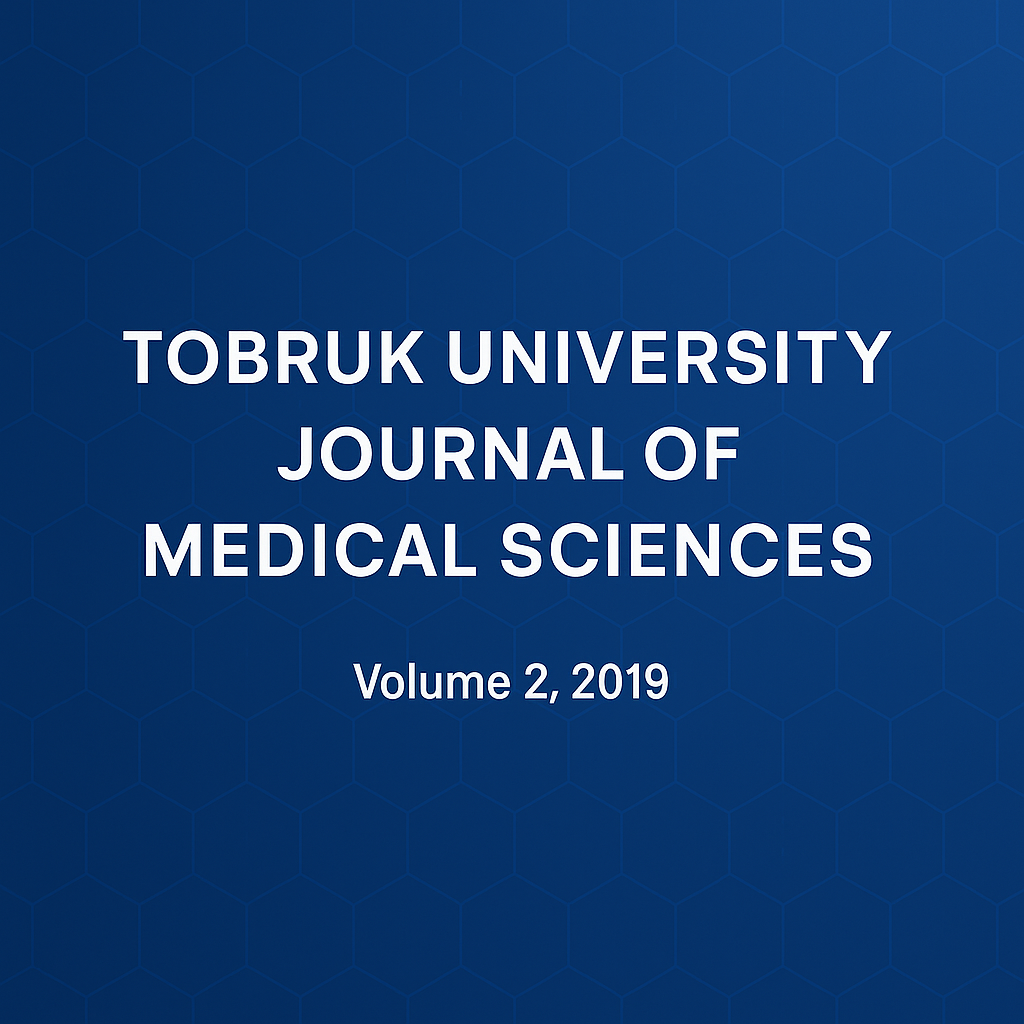Prevalence of Vitamin D Deficiency among Hypothyroid Patients in Benghazi Medical Center.
DOI:
https://doi.org/10.64516/6tyv8412Keywords:
Hypothyroidism,, Thyroid Stimulating Hormone (TSH),, vitamin DAbstract
Vitamin D is a steroid hormone introduced into the body through food, but major synthesis occurs through exposure of the skin to solar ultraviolet light. Vitamin D obtained from the skin or the diet is converted by the liver to 25(OH) vitamin D and is metabolized in the kidney to (1,25) dihydroxyvitaminD.The consequences of low vitamin D level is not only causing osteomalacia, but also found to increase risk of autoimmune thyroid disease. A different gene in the Vitamin D receptor was shown to predispose people to autoimmune thyroid disease including Graves’ disease and Hashimoto’s thyroiditis. Since hypothyroidism is a common endocrine problem in Benghazi, data on the effects of vitamin D supplementation on thyroid function in hypothyroid patients needs to be investigated.
References
1. "Hypothyroidism". (2016). National Institute of Diabetes and Digestive and Kidney Diseases (2013).
2. Garber JR, Cobin RH, Gharib H, et al. (2012). "Clinical practice guidelines for hypothyroidism in adults,: cosponsored by the American Association of Clinical Endocrinologists and the American Thyroid Association"(PDF). Thyroid. (December 2012) 22 (12): 1200–35.
3.Melmed& Conn. (2005). Totowa..Reproduction and fertility. In Endocrinology: Basic and clinical principles. 2nd Edition Edited by, N.J,: Human Press. Schwartz.
4. Marzouka, G. ,Cortazar, F. , Alvarez, J. A., Dias, A. and Hebert, K.. (2011). Racial and Sex Differences in Prevalence of Hypothyroidism in Patients With Cardiomyopathies Enrolled into a Heart Failure Disease Management Program. Congestive Heart Failure, 17: 133-139.
5. Chakera AJ, Pearce SH, Vaidya B. (2012) "Treatment for primary hypothyroidism: current approaches and future possibilities". Drug Design, Development and Therapy (Review). (2012). 6: 1–11.
6. Holick MF (2007). Vitamin D deficiency. N Engl J Med 2007;357:266- 281.
7. Institute of Medicin. (2010). Food and Nutrition Board. Dietary Reference Intakes for Calcium and Vitamin D. Washington, DC: National Academy Press.
8. Deluca HF. (2008). Evolution of our understanding of vitamin D. Nutr Rev. 2008; 66(10):73–87. [PubMed]
9. Baeke F, Takiishi T, Korf H, Gysemans C, Mathieu C. (2010). Vitamin D: modulator of the immune system. Curr. OpinPharmacol. 10(4):482–96. [PubMed]
10. Tamer G, Arik S, Tamer I, Coksert D. (2011). Relative vitamin D insufficiency in
Hashimoto’s thyroiditis.Thyroid. 21(8):891–96. [PubMed]
11. Caturegli P, De Remigis A & Rose NR. (2014). Hashimoto thyroiditis: clinical and diagnostic criteria. Autoimmunity Reviews 13 391–397.
12.McLeod DS & Cooper DS. (2008). The incidence and prevalence of thyroid autoimmunity. Endocrine 2015 42 252–265.
13.Hollick MF, chen TC. Vitamin D deficiency a worldwide problem consequence .AmjClin Nutr.;87:10805-68.(PubMed).
14. MariamOmar,FaizaNouh,ManalYounis,MoftahYounis,NesmaNabil, MarwaSaad and Munyah Ali. (2017). Vitamin D Status and Contributing Factors in Patients Attending Three Polyclinics in Benghazi Libya. Journal of Advances in Medicine and Medical Research 24(5): 1-13, Article no.JAMMR.37483 ISSN: 2456-8899
15. Deluca HF. (2008). Evolution of our understanding of vitamin D .Nutr Rev.;66(10): 73-87. [punMed].
16.Friedman Theodore C .(2019). Vitamin D deficiency and Thyroid Disease. Available from: www.goodhormonehealth.com/ Vitamin D.
17. GR, Gupta A. (2014). Vitamin D deficiency in India: Prevalence, causalities and interventions. Nutrients;6:729-75.
18. Mackawy AM, Al-Ayed BM, Al-Rashidi BM. (2013). Vitamin d deficiency and its association with thyroid disease. Int J Health Sci (Qassim);7:267-75.
19. Byron Richards. (2008). Low Vitamin D contributes to Thyroid Problems. Health News.
20. PalwatwichaiA.(2001).TuberculosisinThailand.Respirology.6(1):65– 70. [PubMed].
21. WHO .(2014). Global Tuberculosis Report. WHO Press, World Health Organization, Geneva. ISBN 978 92 4 156480 9.
22. Gauvain S. (1948). Calciferol in the treatment of tuberculous glands. Tubercle. Nov;29(11):259–264. [PubMed]
23. ChocanoBedoyaP,RonnenbergAG.(2009),VitaminDandtuberculosis. Nutr Rev. 67(5):289–293. [PubMed]
24. Nnoaham KE, Clarke A. (2008). Low serum vitamin D levels and tuberculosis: a systematic review and meta-analysis. Int J Epidemiol. 2008 Feb;37(1):113– 119.[PubMed]
25. Zhou S, Chan E, Lim LY, et al. (2004). Therapeutic drugs that behave as
mechanismbased inhibitors of cytochrome P450 3A4. Curr Drug Metab. Oct;5(5):415– 442. [PubMed].
26. Wang Z, Lin YS, Zheng XE, Senn T, Hashizume T, Scian M, et al. (2012). An inducible cytochrome P4503A4-dependent vitamin D catabolic pathway. MolPharmacol. 81(4):498–509. [PMC free article][PubMed]
27. Cortney Bosworth, Ian H. (2013). de Boer SeminNephrol. Author manuscript; available
in PMC 2014 March 1. Published in final edited form as: SeminNephrol33(2):158–68.
28. Raviglione MC, O’Brein RJ. (2011). Principles of Internal Medicine by
Harrison’s. 18th edition. Volume-I. USA: Mcgraw-HillInc1. Tuberculosis. In: Longo DL, Fauci AS, Kasper DL, Hauser SL, Jameson JL, Loscalzo J, editors; pp. 1340–57.
29. Ralph AP, Lucas RM, Norval M. Vitamin D and solar ultraviolet radiation in the risk and treatment of tuberculosis. Lancet Infect Dis. 2013;13(1):77–88. [PubMed].
30 .Menon B, Harinarayan CV. (2010).The effect of anti epileptic drug therapy on serum 25-hydroxyvitamin D and parameters of calcium and bone metabolism—A longitudinal study. Seizure 19:153–8.
31. Krishnamoorthy G, Nair R, Sundar U, Kini P, Shrivastava M. (2010). Early predisposition to osteomalacia in Indian adults on phenytoin or valproate monotherapy and effective prophylaxis by simultaneous supplementation with calcium and 25-hydroxy vitamin D at recommended daily allowance dosage: a prospective study. Neurol India 58(2):213–9.
32. Borusiak P, Langer T, Heruth M, Karenfort M, Bettendorf U, Jenke AC. (2013).
Antiepileptic drugs and bone metabolism in children: data from 128 patients. J Child Neurol 28(2):176–83












